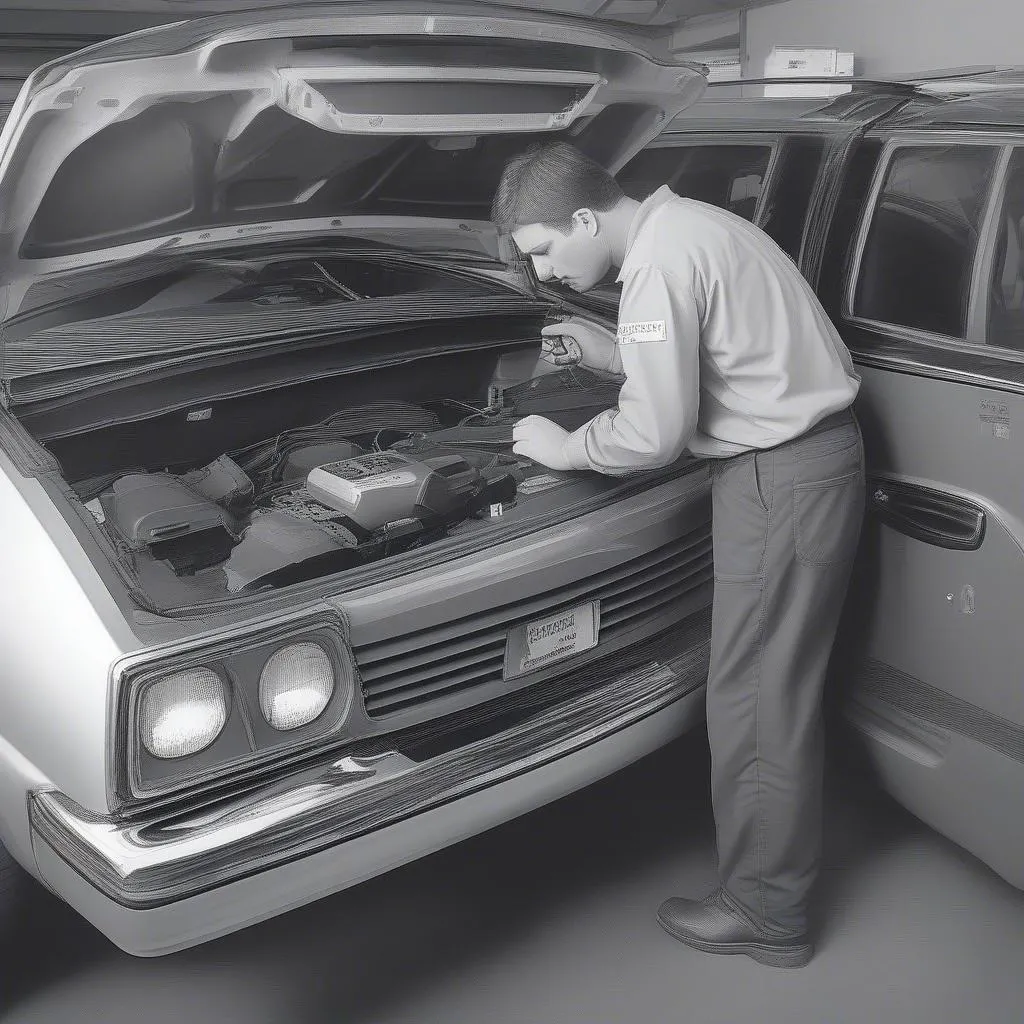Imagine this: You’re driving down the highway, enjoying the open road, when suddenly your car starts acting up. The engine light flashes, the car loses power, and you’re left stranded on the side of the road. You call a mechanic, but they can’t diagnose the problem without the right tools. This is where a bi-directional scanner comes in.
What is a Bi-Directional Scanner?
A bi-directional scanner is a powerful diagnostic tool used by mechanics and car enthusiasts to troubleshoot and repair modern vehicles. It’s a step above a traditional OBD2 scanner, providing not just read-only data but also the ability to interact with the car’s electronic systems, allowing you to control actuators, test components, and even reprogram the car’s computer.
The Importance of Bi-Directional Functionality
Let’s delve deeper into why bi-directional scanners are crucial for efficient car repair.
Understanding the Need:
- Imagine needing to test the functionality of a specific actuator, such as a solenoid valve. A traditional scanner would only show you the data, while a bi-directional scanner allows you to actually command the actuator to activate and observe its behavior.
- When troubleshooting complex issues that require adjusting parameters or reprogramming specific modules, a bi-directional scanner enables you to perform these actions, making the repair process much more efficient.
Real-World Examples:
- A mechanic using a bi-directional scanner in Los Angeles was able to diagnose a stuck fuel injector by commanding it to open and close, confirming its malfunction.
- In New York City, a car enthusiast used a bi-directional scanner to reprogram the throttle position sensor on their European car, restoring its smooth acceleration.
Bi-Directional Scanners: A Deeper Dive
Features of a Bi-Directional Scanner:
- Live Data Stream: See real-time data from various sensors and modules.
- Active Testing: Control actuators, test components, and perform diagnostics.
- Coding & Programming: Adjust parameters, reprogram modules, and update software.
- Diagnostic Trouble Codes (DTCs): Read and clear error codes.
Types of Bi-Directional Scanners:
- OBD2 Scanners: Widely compatible with most cars produced after 1996, but with limited functionality for newer cars.
- Manufacturer-Specific Scanners: Designed for specific car brands, providing comprehensive diagnostics and programming capabilities.
- Advanced Scanners: Offer extensive features, including multi-language support, data logging, and more.
Frequently Asked Questions about Bi-Directional Scanners
1. What are some popular brands of bi-directional scanners?
Some reputable brands include Autel, Launch, Snap-on, AutoBoss, and Foxwell. These brands offer a wide range of scanners, from budget-friendly options to professional-grade devices.
2. Do I need a bi-directional scanner for every car I work on?
It depends on the complexity of the issue you’re trying to diagnose and the specific model of the car. For basic repairs, an OBD2 scanner might suffice. However, if you’re dealing with more complex electronic issues, a bi-directional scanner is a valuable investment.
3. Can I use a bi-directional scanner to reprogram my car’s ECU?
This depends on the specific scanner and the car model. Some high-end scanners have the capability to reprogram the ECU, while others are limited to basic diagnostics and coding. It’s essential to check the scanner’s specifications and compatibility with your vehicle.
 Bi-Directional Scanner Repairing a Car
Bi-Directional Scanner Repairing a Car
Using a Bi-Directional Scanner: A Step-by-Step Guide
Step 1: Connect the Scanner: Connect the scanner to the vehicle’s OBD2 port, usually located under the dashboard.
Step 2: Select Vehicle Information: Enter the vehicle’s make, model, and year to ensure compatibility with the scanner.
Step 3: Diagnose the Issue: Utilize the scanner’s diagnostic features to read error codes, check live data, and perform active tests on specific components.
Step 4: Analyze Data: Carefully analyze the data provided by the scanner to identify the root cause of the problem.
Step 5: Repair the Issue: Use the scanner’s bi-directional capabilities to control actuators, reprogram modules, or perform other necessary repairs.
Step 6: Clear Error Codes: Once the issue is resolved, clear the error codes from the vehicle’s computer.
Step 7: Test Drive: After repairs, test drive the vehicle to ensure the issue is fully resolved.
Choosing the Right Bi-Directional Scanner for Your Needs
Consider these factors when selecting a bi-directional scanner:
- Vehicle Compatibility: Ensure the scanner supports your car’s make, model, and year.
- Features: Determine the specific features you require, such as live data streaming, active testing, coding, and programming.
- Price: Bi-directional scanners can range in price from a few hundred dollars to several thousand dollars, depending on their capabilities and brand.
- Ease of Use: Choose a scanner with a user-friendly interface and clear instructions.
 Mechanic using a bi-directional scanner
Mechanic using a bi-directional scanner
Learn More About Bi-Directional Scanners
Interested in learning more about bi-directional scanners? Visit our website for more detailed articles and resources, including:
- Bi-Directional OBD2 Scanners
- OBD2 Bi-Directional Scanner Programmer
- Cheapest Scanner with Bi-Directional
- Best Bi-Directional Bluetooth OBD2 Scanner
- Autel Maxidas DS708 Bi-Directional
Need Expert Help?
Don’t hesitate to reach out to our team of experts at Diag XCar. We offer comprehensive diagnostics, repair services, and guidance on selecting the right bi-directional scanner for your needs.
Contact us via Whatsapp: +84767531508 for instant assistance and expert advice.
 Car Diagnostics and Repair
Car Diagnostics and Repair
Conclusion
Bi-directional scanners are essential tools for anyone serious about diagnosing and repairing modern cars. They offer the ability to interact with the vehicle’s electronic systems, allowing you to perform advanced diagnostics, control actuators, and even reprogram modules. By investing in a high-quality bi-directional scanner, you’ll be equipped to tackle even the most complex automotive challenges.
Leave a comment below to share your experiences with bi-directional scanners or any questions you have about car diagnostics. We’re happy to hear from you!